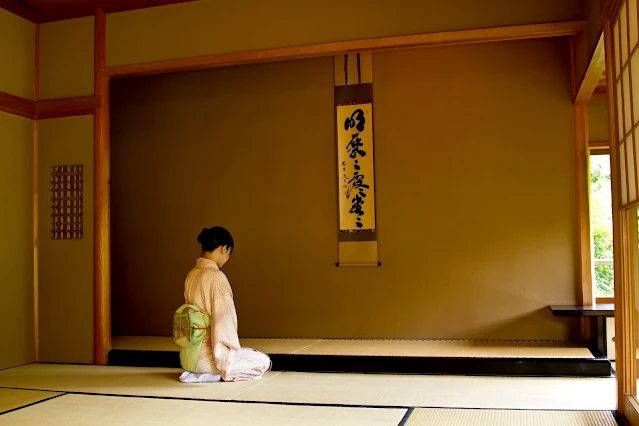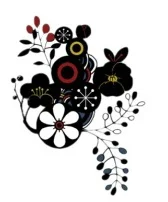
The art of Japanese hanging scrolls, known as "kakejiku" or "kakemono," holds a significant place in Japanese culture and tradition.
These scrolls, adorned with calligraphy or East Asian paintings, are carefully mounted on silk or paper and displayed in various settings, such as tokonoma (alcoves) or Buddhist altars.
They not only enhance the aesthetic appeal of a space but also serve as a means of expressing one's thoughts and emotions.
{tocify} $title={Table of Contents}
Origins and Evolution of Japanese Hanging Scrolls
Japanese hanging scrolls have their roots in China, specifically during the Song Dynasty.
Initially used for religious purposes, these scrolls gradually found their way into Japanese culture and underwent significant development.
During the Kamakura period, influenced by Zen Buddhism, the popularity of ink paintings led to the expansion of hanging scrolls beyond religious contexts.
The tea ceremony, introduced during the Muromachi period, further propelled the use of hanging scrolls in Japanese homes, particularly in the tokonoma, where they became an integral part of the tea room's ambiance.
Types of Japanese Hanging Scrolls
Japanese hanging scrolls come in various forms and styles, each serving a particular purpose or representing a specific theme.
Some common types include:
- Buddhist Scrolls: These scrolls feature religious imagery, including paintings of Buddha, bodhisattvas, or Buddhist scriptures.
- Nature and Landscape Scrolls: Depicting natural scenery, such as mountains, rivers, and forests, these scrolls capture the beauty of the changing seasons and the harmony between humans and nature.
- Floral and Bird Scrolls: These scrolls showcase delicate paintings of flowers and birds, symbolizing beauty, freedom, and the ephemeral nature of life.
- Calligraphy Scrolls: Focusing on the art of calligraphy, these scrolls display elegant and expressive writing, often featuring poems, proverbs, or philosophical quotes.
The Art of Mounting and Displaying Hanging Scrolls
The process of mounting and displaying hanging scrolls is meticulous and requires attention to detail.
A properly mounted scroll enhances its visual impact and longevity.
Here are the essential steps involved:
- Unrolling the Scroll: Carefully untie the silk or paper wrapping and unroll the scroll, taking care not to damage the delicate surface.
- Hanging the Scroll: Using a hanging pole or "jiku," attach the scroll to a wall or a specially designed scroll hanger. Adjust the height and position of the scroll to ensure proper visibility and balance within the space.
- Appreciating the Scroll: Take time to contemplate and appreciate the artwork on the scroll. The choice of the scroll and its placement should harmonize with the surrounding environment, reflecting the viewer's taste and sensibilities.
- Caring for the Scroll: Protect the scroll from direct sunlight, excessive humidity, and pests. Regularly dust the surface with a soft brush and consider professional restoration and remounting when necessary.
The Significance of Japanese Hanging Scrolls
Japanese hanging scrolls hold deep cultural significance and reflect the artistic sensibilities of the Japanese people.
They not only add beauty and elegance to interior spaces but also convey messages, emotions, and philosophical concepts.
The choice of a particular scroll for a specific occasion or setting can express personal beliefs, commemorate special events, or invoke a particular mood.
Moreover, Japanese hanging scrolls serve as a bridge between the past and the present, connecting generations and preserving traditional artistic techniques.
They are treasured as valuable cultural artifacts, with many antique scrolls considered national treasures in Japan.
The appreciation of hanging scrolls continues to evolve, with contemporary artists and craftsmen creating innovative designs while staying true to the essence of this traditional art form.
Exploring Japanese Hanging Scrolls Today
In contemporary Japan, hanging scrolls can be found in various settings, from traditional Japanese homes to art galleries and museums.
They are appreciated by art enthusiasts, collectors, and those seeking to infuse their spaces with a touch of Japanese elegance.
Additionally, the popularity of hanging scrolls has extended beyond Japan's borders, with art lovers worldwide recognizing their unique beauty and cultural significance.
Japanese hanging scrolls are not only admired for their aesthetic appeal but also cherished for the stories they tell and the emotions they evoke.
They invite viewers to contemplate the beauty of nature, appreciate the artistry of calligraphy, and connect with the rich cultural heritage of Japan.
Embrace the timeless beauty and profound meaning of Japanese hanging scrolls as you embark on a journey through Japan's artistic and cultural landscape.
Experience the tranquility, elegance, and deep-rooted traditions they embody, and let them inspire you to create your own personal sanctuary of beauty and contemplation.
Japanese hanging scrolls, with their intricate artwork and rich cultural heritage, continue to captivate audiences worldwide.
From their origins in China to their evolution in Japan, these scrolls have become an integral part of Japanese culture, art, and aesthetics.
Whether displayed in traditional Japanese homes or contemporary settings, they add a touch of elegance and contemplation to any space.
As you explore the world of Japanese hanging scrolls, you'll discover a treasure trove of artistic expression and cultural significance that transcends time and borders.

Your Gateway to Japan's Wonders! Immerse yourself in the beauty, culture, and adventures that Japan has to offer.
Check It Out!